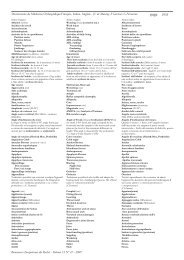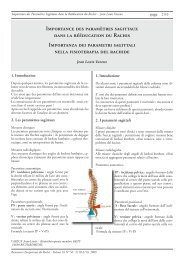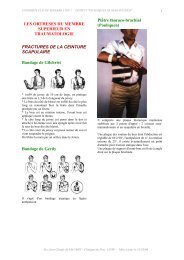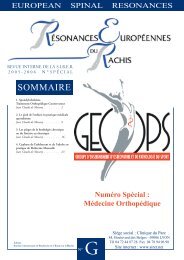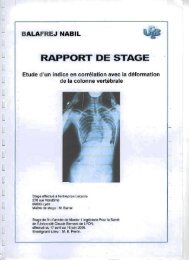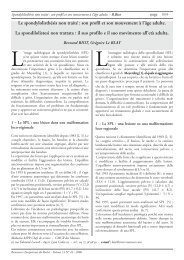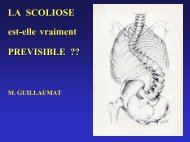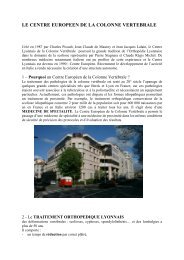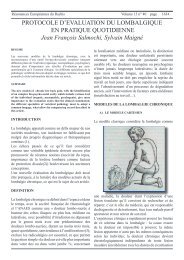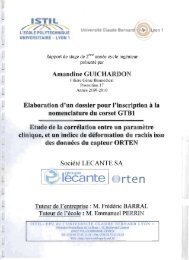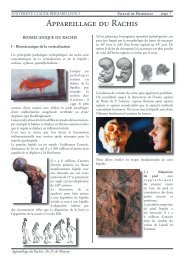Indication du Traitement Conservateur
Indication du Traitement Conservateur
Indication du Traitement Conservateur
You also want an ePaper? Increase the reach of your titles
YUMPU automatically turns print PDFs into web optimized ePapers that Google loves.
Progression of Scoliosis <strong>du</strong>ring puberty - making therapeutic decision - JC de Mauroypage 1Evolutivité Scoliotique en période Pubertaire :<strong>Indication</strong> <strong>du</strong> <strong>Traitement</strong> <strong>Conservateur</strong>Jean Claude de MauroyIl existe un consensus pour débuter un traitement orthopédiqueconservateur lorsque l’angulation Cobb de la scoliose dépasse 25° chezl’enfant et l’adolescent. Les facteurs biomécaniques d’aggravation sontbien connus.Nous sommes tous conscients que la mise en place d’un corset mêmenocturne, outre le coût pour la société, a des répercussions physiques etpsychologiques sur la croissance de l’enfant.De plus, le traitement permet une stabilisation de l’angulation scoliotiquemais non le retour à un rachis rectiligne (échec de l’objectif zéro).Le dépistage de plus en plus précoce des scolioses fait que nousvoyons en consultation beaucoup de courbures dont l’angulationest comprise entre 10° et 25°, et pour lesquelles nous n’avonspas la certitude d’une évolution. Dès lors, pour une scoliosedécouverte par exemple à 15°, deux attitudes sont possibles :- traitement préventif dès la découverte de la scoliose avec risquede mettre en place un corset pour une scoliose non évolutive- kinésithérapie d’attente jusqu’à aggravation à 25°, sachant qu’ilfaudrait mieux stabiliser la scoliose à 15° qu’à 25°.L’intégration récente de la théorie <strong>du</strong> chaos permet de mieuxpréciser notre stratégie thérapeutique et le concept biomécaniqued’intégrité tensionnelle de Buckminster Fuller de mieux enpréciser les protocoles.1. QUEL EST LE ROLE DE LA LATERALISATION ET DEL’ASYMETRIE DANS LA SURVENUE D’UNE SCOLIOSE ?Le développement de la parole chez l’homo habilis il y a 2 millionsd’années a ren<strong>du</strong> asymétriques les deux hémi-cerveaux avec 90%d’homo sapiens droitiers et 10% de gauchers.L’ontogenèse repro<strong>du</strong>isant la phylogenèse, cette latéralisationsurvient chez l’enfant vers l’âge de 7 ans, moment où il commenceà tendre spontanément la main droite et à acquérir une bipédie etune marche de type a<strong>du</strong>lte. C’est également à ce moment que seconstitue son morphotype dans le plan sagittal.- Avant l’âge de 7 ans, les scolioses thoraciques se répartissentmoitié à droite, moitié à gauche.- Après l’âge de 7 ans, les courbures sont thoracique droitesdans 90% des cas, les gauchers présentent souvent des scoliosesthoraciques gauches. Ce n’est donc pas l’asymétrie des organes(cœur, foie, ...) mais l’asymétrie cérébrale qui conditionne le côtéde la scoliose. (figure 1)La croissance pubertaire est également une caractéristique del’homo sapiens avec gain de taille de 25 cm en quelques annéesessentiellement au niveau <strong>du</strong> rachis.C’est <strong>du</strong>rant cette croissance pubertaire que se constituent lamajorité des scolioses. Cette croissance s’effectue au niveau del’os et est freinée latéralement par les ligaments, la musculature,les fascias. C’est sans doute le «freinage» asymétrique qui expliquele développement d’une scoliose. Lorsque ce frein n’existe pas,comme dans la maladie de Marfan, nous constatons d’importantesmodifications de la structure osseuse.Le rachis se comporte comme un système non linéaire d’intégritétensionnelle avec structure osseuse en compression discontinueet système musculo-ligamentaire en tension continue. L’intégritétensionnelle explique le caractère omnidirectionnel <strong>du</strong> rachis. Enpériode de croissance rapide, ce système est davantage sollicité etla scoliose peut être comparée à une voiture dont les freins seraientmal équilibrés.C’est le rôle <strong>du</strong> corset plâtré en début de traitement deréajuster les tensions ligamentaires entre convexité et concavité.La croissance s’effectuant essentiellement <strong>du</strong>rant la nuit, letraitement conservateur peut être nocturne pour une scoliosedont l’angulation est inférieure à 30°.2. PEUT ON PREVOIR LA PROGRESSION D’UNESCOLIOSE ?Il est admis, que l’origine de la scoliose est multi-factorielle.En-dessous d’une angulation de 25° Cobb, l’évolution de lascoliose est imprévisible, c’est-à-dire qu’un petit élément vapouvoir déclencher une scoliose évolutive majeure, on peut ainsiparler de chaos déterministique.Au-delà de 25°, il existe un cercle vicieux évolutif biomécanique.- Dans un plan frontal, la vertèbre apicale s’éloigne de la ligne degravité, ce qui augmente considérablement les pressions au niveaude la concavité, c’est la balance vertébrale. D’après les lois de Wolf& Delpech, en période de croissance, toute hyperpression osseusefreine la croissance osseuse et favorise ainsi la cunéiformisation dela vertèbre apicale. (figure 3)- Dans un plan horizontal, une rotation apicale de plus de 25°,entraîne automatiquement une accentuation de la scoliose lors dela flexion <strong>du</strong> tronc en avant. (figure 4)- Dans un plan sagittal, le dos plat diminue la résistance <strong>du</strong> rachiset un phénomène de « flambage » accentue encore l’évolutionscoliotique.Pour les scolioses poliomyélitiques, Mme Duval Beaupère, adécrit une courbe évolutive affine par parties avec deux pointsd’inflexion : le premier se situant en début de croissancepubertaire, le second à maturité osseuse. (figure 2)Ce concept ne convient pas pour les scolioses idiopathiques. Eneffet, la croissance n’est pas linéaire entre 11 et 15 ans et le premierpoint d’inflexion survient fréquemment en milieu ou en fin decroissance pubertaire.Si nous connaissons les signes cliniques et radiologiquescaractérisant les scolioses évolutives, aucun de ces signes n’est uncritère permettant d’effectuer un pronostic. Le seul élément quiressort des études informatisées, est l’angulation supérieure à 25°en période de croissance pubertaire ce qui correspond au cerclevicieux biomécanique que nous avons évoqué.3. EN PRATIQUE QUELLES SONT LES CONSEQUENCESDE L’APPLICATION DE LA THEORIE DU CHAOS ?1. Le traitement de la scoliose ne peut être que symptomatique.On ne va pas à la chasse au papillon au Brésil pour éviter latornade au Texas. Si la scoliose s’accompagne d’un défaut deClinique <strong>du</strong> Parc - 84 Bd des Belges 69006 Lyon - www.demauroy.net
Progression of Scoliosis <strong>du</strong>ring puberty - making therapeutic decision - JC de Mauroypage2l’articulé temporo-mandibulaire ou d’un pied plat, il faudratraiter chaque symptôme séparément sans avoir la prétentionde corriger une scoliose par un traitement orthodontique ou dessemelles orthopédiques.2. Pour une scoliose de 15° par exemple, il faut avoir consciencede l’imprévisibilité de cette scoliose et en informer les parents, afind’éviter deux attitudes totalement opposées :- rassurer à tort ce qui pourrait aboutir à l’absence de surveillanceet de contrôle,- inquiéter à tort en mettant en place un corset préventif inutilepour des scolioses non évolutives, comme cela a été le cas danscertains school-screening aux Etats Unis.3. Il n’existe pas de traitement préventif de la scoliose, par contredans certains cas, nous pouvons être amenés à effectuer untraitement précoce.4. EXISTE-IL DES ÉLÉMENTS CLINIQUES OURADIOLOGIQUES, POUVANT JUSTIFIER UNTRAITEMENT PRÉCOCE POUR UNE ANGULATIONCOMPRISE ENTRE 10 ET 25° ?Oui. L’association de deux prédicteurs peut justifier un traitementprécoce :- familiarité au premier degré (frères et sœurs, ou parentsprésentant une scoliose de + 25°)- évolution de plus de 10° par an,- courbure lombaire ou thoraco-lombaire,- syndrome <strong>du</strong> dos plat avec cyphose inférieure à 10°- rotation de plus de 25°, ou gibbosité de plus de 25mm auniveau thoracique et 15mm au niveau lombaire,5. QUAND ET QUELLE REEDUCATION PRESCRIRE ?La kinésithérapie ne freine que très peu l’évolution d’unescoliose idiopathique en période pubertaire. L’évocation de lathéorie <strong>du</strong> chaos permet de mieux faire percevoir la place de lakinésithérapie. Si l’on peut assimiler l’évolution scoliotique à unautre phénomène chaotique tel que le tremblement de terre,la kinésithérapie constitue une construction anti-sismique quin‘empêche pas le tremblement de terre, mais qui en limite leseffets. Si la scoliose évolue malgré la réé<strong>du</strong>cation, ce ne sera pas lafaute <strong>du</strong> kinésithérapeute.Notre protocole prévoit de débuter systématiquement lakinésithérapie dès le premier bilan d’une scoliose structurale,supérieure à 10°. Il s’agit essentiellement d’une prise de consciencede la position <strong>du</strong> rachis <strong>du</strong>rant les gestes de la vie quotidienne etnotamment en position assise et éventuellement d’une correctionposturale.Par la suite, cette réé<strong>du</strong>cation sera éventuellement poursuivieen fonction de la symptomatologie clinique : raideur, asymétriemusculaire, troubles de l’équilibre...Nous avons vu en biomécanique que la scoliose s’accentuait lorsde la flexion <strong>du</strong> tronc en avant, il faudra donc veiller à limitercette flexion antérieure dans les gestes de la vie quotidienne et lorsde la pratique <strong>du</strong> sport.La kinésithérapie est systématiquement associée à la réalisationd’un traitement orthopédique conservateur.En conclusion,L’indication d’un traitement orthopédique conservateur pourune scoliose inférieure à 25° est sans doute l’un des actes les plusdélicats pour le spécialiste. Nous avons bien conscience <strong>du</strong> regardréprobateur de la maman lorsque nous démarrons le traitementaprès aggravation alors qu’elle nous avait montré l’enfant six moisauparavant.Il faut bien expliquer cette difficulté aux parents lors de lapremière consultation afin d’éviter tout malenten<strong>du</strong>.L’évolution d’une scoliose de moins de 25° est chaotique, iln’existe aucun signe clinique ou radiologique permettant avecexactitude d’affirmer le caractère évolutif de la scoliose, par contrecertains éléments permettent d’envisager un traitement précoce.La réé<strong>du</strong>cation n’empêche pas l’aggravation d’une scolioseévolutive.Figure 1 Figure 2Clinique <strong>du</strong> Parc - 84 Bd des Belges 69006 Lyon - www.demauroy.net
Progression of Scoliosis <strong>du</strong>ring puberty - making therapeutic decision - JC de MauroyProgression of Scoliosis <strong>du</strong>ring Puberty :Making Therapeutic DecisionJean Claude de Mauroypage 3There is a consensus to begin an Orthopaedic ConservativeTreatment when the Cobb’s angle of the scoliosis exceeds 25°concerning children and teenagers.The fitting of a night brace, besides its cost for the society, involvesome physical and psychological consequences on the growth ofthe child.This treatment enables a stabilisation of the Cobb’s angle ofscoliosis but is far from allowing the return of a rectilinear spine.(failure of the objective zero)The earlier and earlier screening of scoliosis leads to the factthat one may see in consultation many curves whose angulationare compound between 10° and 25°, and for which one is notsure about its evolution. Thus, concerning a scoliosis of 15° forinstance, two ways of reacting are possible:- A preventive treatment as soon as the scoliosis is discovered,with a risk of bracing for a scoliosis which is not evolutive.- Waiting until a worsening to 25°, knowing that it is better tostabilize a scoliosis at 15° than at 25°.The recent use of the chaos theory enables us to be more preciseabout our therapeutic strategy and the Buckminster Fuller’sbiomechanics concept of the tensional integrity allows us to bemore precise about protocols.1.What is the role of lateralisation in the occurrence of ascoliosis?The homo habilis’s development of speech 2 millions years agomade the two hemi-brains asymmetrical and had for consequencesthe fact that 90% of homo sapiens were right-handed and 10%left-handed.The ontogeny repro<strong>du</strong>cing the phylogeny, this lateralisation ariseswhen a child is about 7, when he begins to hold the right handspontaneously and when he walks on two legs and acquires ana<strong>du</strong>lt gait. This is also the moment when his sagittal morphotypeis constitute.Before the age of seven, the thoracic scoliosis are spread half onthe right side, half on the left side.After the age of seven, the curves are right thoracic in 90%cases, left-handed often shows left thoracic scoliosis. Thus itis not the asymmetry of organs (heart, leaver), but the brainasymmetry which is conditioning on which side the scoliosiswill take place. (figure 1) The puberty growth is also an homosapiens characteristic, in fact he grows of 25cm <strong>du</strong>ring a few yearsessentially at the spine level.This is <strong>du</strong>ring this puberty growth that most of the scoliosis willbe discovered. This growth which is taking place essentially at thevertebral body level, is slowed by ligaments, muscles, and fascias.The “slowing down” asymmetrical may explain the developmentof a scoliosis. When there is no slowing down, as what can beobserved in Marfan’s disease, we notice major modifications inthe bone structure most of them in a sagittal plan.2. What is the role of asymmetry in the evolution of ascoliosis?The spine is working as a tensional integrity system with abone structure in a discontinuous compression and a muscleand ligament structure in a continuous tension. The tensionalintegrity explains the fact that the movement of the spine is omnidirectional . In a period of quick growth, this system is more usedand one can compare a scoliosis with a car whose brakes wouldnot be balanced.Thus the plaster cast will play this role at the beginning of thetreatment: it will balance the ligament tensions between convexityand concavity. The growth taking place mostly at night, theconservative treatment may be nocturnal for a scoliosis whoseangulation will be inferior to 30°.3. Is it possible to foresee the progression of a scoliosis?It is generally admitted, that the origin of a scoliosis is multifactorial.Considering the scoliosis which are caused by a poliomyelitis,Mrs Duval Beaupère has described a progressive curve affine byparts with two points of inflexion: the first one is localised at thebeginning of the puberty growth, the second at the maturity ofthe bones. (figure 2)This concept doesn’t fit for idiopathic scoliosis. In fact, the growthis not linear between the age of 11 and 15 years old and the firstpoint of inflexion happens frequently in the middle or at the endof the puberty growth.Lower than 25° of Cobb’s angle, the evolution of a scoliosis cannot be foreseen, that is to say that one minor element may launcha major scoliosis which is likely to progress, thus one may talkabout a determinist chaos.Beyond 25°, there is a biomechanical progressive vicious circle.Admitting a frontal plan, the apical vertebra moves away fromthe gravity line, which is increasing considerably the concavepressures, it’s called the vertebral balance. (figure 3)Admitting an horizontal plan, an apical rotation more than 25°,entails automatically a worsening of the scoliosis <strong>du</strong>ring theforward bending of the trunk. (figure 4)Considering the Wolf and Delpech laws, <strong>du</strong>ring the period ofgrowth, the concave hyperpression, slows down the bony growthand contributes thus the cuneiformisation of the apical vertebra.Admitting a sagittal plan, the flat back diminishes the spineresistance and a “buckling” phenomena still accentuates theevolution of the scoliosis.4. Are there some clinical or radiological signs to predicta progressive scoliosis?No. If one knows the clinical and radiological signs characterisingClinique <strong>du</strong> Parc - 84 Bd des Belges 69006 Lyon - www.demauroy.net
Progression of Scoliosis <strong>du</strong>ring puberty - making therapeutic decision - JC de Mauroypage 4progressive scoliosis, none of those signs is a criteria allowingto make a prognosis. The only element which is striking fromcomputerised studies, is the angulation above 35° <strong>du</strong>ring thepuberty growth which corresponds to the vicious biomechanicalcircle that we have already mentioned.5. In practice, what are the consequences of theapplication of the theory of chaos?1. The treatment of a scoliosis may only be symptomatic. Oneis not going to hunt butterflies in Brazil to escape from the TexanTornado. If the scoliosis is accompanied by a physical defect of thetemporo-mandibular joint or a flat foot, one have to treat eachsymptom separately without wanting to correct a scoliosis by anorthodontic treatment or by orthopaedic soles.2. Considering a scoliosis of 15° for instance, one must beconscious of the unpredictability of the scoliosis and to informthe parents about that, therefore one must avoid two drasticallyopposed attitudes:- reassure with no practical basis and this could lead to nosupervision and no control,- worry with no practical basis by fitting a preventive brace whichis useless for a non progressive scoliosis, as it has been done insome school-screening in the United States.3. There is no preventive treatment for scoliosis, but in somecases, one may be lead to make an early treatment.6. Are there clinical or radiological elements which canjustify an early treatment considering an angulationcompounds between 10° and 25°?Yes. The association of two predictive elements may justify anearly treatment:- familiarities concerning siblings, or parents who have a scoliosismore than 25°.- evolution of more than 10° each year,- lumbar curves or thoracolumbar curves- syndrome of flat spine with a Kyphosis inferior to 10°- rotation more than 25°, or gibbosity more than 25mm at thethoracic level and 15mm at the lumbar level7.When and what physiotherapy should one prescribe?The physiotherapy is only slowing down a little bit the progressionof an idiopathic scoliosis <strong>du</strong>ring puberty. The evocation ofthe theory of chaos let in a netter way perceive the role of thephysiotherapy. If one can assimilate the progression of a scoliosisto another chaotic phenomena as the earthquakes, physiotherapymay be considered as an anti-seismic building which doesn’tprevent from earthquakes, but which is limiting the negativeeffects. If the scoliosis is progressing in spite of rehabilitation, itwill not be the physiotherapist fault.Our protocol foresee to begin systematically physiotherapyfor the first checkup of a structural scoliosis, above 10°. It isessentially about being conscious of the place of the spine <strong>du</strong>ringthe everyday gestures and especially while sitting and eventuallyin a postural correction.Following, the rehabilitation will be eventually continuedaccording of the clinical symptomatology: straightness, muscularasymmetry, troubles of balance…It has been seen in biomechanical that scoliosis would increase<strong>du</strong>ring the forward bending of the trunk, one must be carefulto limit this anterior flexion in everyday gestures and whilepracticing sports.The physiotherapy is systematically associated to the realisation ofan orthopaedic conservative treatment.Conclusion,The indication of an orthopaedic conservative treatment fora scoliosis less than 25° is without any doubts one of the mostdelicate act for a specialist. We are all aware of the accusative lookof the mother when we start a treatment after aggravation of thescoliosis even if we have seen the child 6 months before.This difficulty has to be explained to the parents <strong>du</strong>ring the firstappointment in order to avoid any misunderstood.This evolution of a less than 25° scoliosis is chaotic, there areno clinical or radiological signs allowing to affirm preciselythe character progressive of the scoliosis, on the other side someelements allow to view an early treatment.The rehabilitation does not prevent the aggravation of aprogressive scoliosis.Figure 3 Figure 4Clinique <strong>du</strong> Parc - 84 Bd des Belges 69006 Lyon - www.demauroy.net



